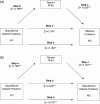Psychopathology and adversities from early- to late-adolescence: a general population follow-up study with the CBCL DSM-Oriented Scales
- PMID: 22794669
- PMCID: PMC6998315
- DOI: 10.1017/S2045796012000145
Psychopathology and adversities from early- to late-adolescence: a general population follow-up study with the CBCL DSM-Oriented Scales
Abstract
Aims. Adolescence is a critical transition phase between childhood and adulthood, when the burden of mental disorder may still be prevented. The aim of this study was to evaluate the continuity and discontinuity of behavioural problems in adolescence while taking into account the multiple co-variation of psychopathological traits and the complex role of recent stressful life events (SLEs). Methods. This is a 5-year follow-up investigation of emotional and behavioural problems assessed by the newly developed Child Behavior Checklist (CBCL) DSM-Oriented Scales (DOSs) in 420 general population subjects aged 15-19 years. Results. The DOSs showed good stability, even when multiple co-variation was taken into account. Longitudinal data showed that homotypic evolution of psychopathology was to be expected in the first place. Equifinality and multifinality were also found. Oppositional Defiant Problems emerged to be polyvalent predictors of both internalizing and externalizing problems. Furthermore, Oppositional Defiant Problems predicted more SLEs, which in turn predicted more Depression, Anxiety and Oppositional Defiant Problems. Mediational analyses confirmed the role of SLEs in partially accounting for the continuity of Oppositional Defiant Problems and for the heterotypic progression towards Affective Problems. Conclusions. These data underscore early adolescence behavioural problems as an important focus for primary and secondary intervention.
Figures

Similar articles
-
The ability of CBCL DSM-oriented scales to predict DSM-IV diagnoses in a referred sample of children and adolescents.Eur Child Adolesc Psychiatry. 2013 Apr;22(4):235-46. doi: 10.1007/s00787-012-0343-0. Epub 2012 Nov 9. Eur Child Adolesc Psychiatry. 2013. PMID: 23138539
-
Co-occurring internalizing and externalizing psychopathology in childhood and adolescence: a network approach.Eur Child Adolesc Psychiatry. 2018 Nov;27(11):1449-1457. doi: 10.1007/s00787-018-1128-x. Epub 2018 Mar 8. Eur Child Adolesc Psychiatry. 2018. PMID: 29520540
-
[Continuities and discontinuities of psychopathology from childhood to adulthood].Psychiatriki. 2012 Jun;23 Suppl 1:15-26. Psychiatriki. 2012. PMID: 22796970 Greek, Modern.
-
Annual Research Review: Stability of psychopathology: lessons learned from longitudinal population surveys.J Child Psychol Psychiatry. 2023 Apr;64(4):489-502. doi: 10.1111/jcpp.13737. Epub 2022 Dec 12. J Child Psychol Psychiatry. 2023. PMID: 36504345 Review.
-
[Mood disorders in childhood and adolescence: continuities and discontinuities to adulthood].Psychiatriki. 2012 Jun;23 Suppl 1:94-100. Psychiatriki. 2012. PMID: 22796978 Review. Greek, Modern.
Cited by
-
A general population twin study of conduct problems and the auditory P300 waveform.J Abnorm Child Psychol. 2014;42(5):861-9. doi: 10.1007/s10802-013-9836-7. J Abnorm Child Psychol. 2014. PMID: 24337737
-
Factors associated with pharmacological treatment in children with attention-deficit/hyperactivity disorders: a retrospective study of a series of 77 cases in a single third-level reference Centre in Apulia region.Ital J Pediatr. 2023 Nov 14;49(1):150. doi: 10.1186/s13052-023-01560-2. Ital J Pediatr. 2023. PMID: 37957732 Free PMC article.
-
Effect of the serotonin transporter gene and of environment on the continuity of anxiety and depression traits throughout adolescence.Epidemiol Psychiatr Sci. 2014 Dec;23(4):399-409. doi: 10.1017/S2045796013000565. Epub 2013 Oct 22. Epidemiol Psychiatr Sci. 2014. PMID: 24148106 Free PMC article.
-
Heterogeneity in maternal and child mental health responses to the COVID-19 pandemic.Early Child Res Q. 2022 2nd Quarter;59:203-214. doi: 10.1016/j.ecresq.2021.12.004. Epub 2021 Dec 20. Early Child Res Q. 2022. PMID: 34955597 Free PMC article.
-
Factors affecting the utilization of mental health services among undergraduate students in a Nigerian University.Heliyon. 2022 Nov 9;8(11):e11476. doi: 10.1016/j.heliyon.2022.e11476. eCollection 2022 Nov. Heliyon. 2022. PMID: 36406704 Free PMC article.
References
-
- Achenbach TM, Rescorla LA (2001). Manual for ASEBA School-Age Forms and Profiles. University of Vermont, Research Center for Children, Youth, & Families: Burlington, VT.
-
- Achenbach TM, Howell CT, McConaughy SH, Stanger C (1995). Six-year predictors of problems in a national sample of children and youth: I. Cross-informant syndromes. Journal of the American Academy of Child and Adolescent Psychiatry 34, 336–347. - PubMed
-
- Amone-P'Olak K, Ormel J, Huisman M, Verhulst FC, Oldehinkel AJ, Burger H (2009). Life stressors as mediators of the relation between socioeconomic position and mental health problems in early adolescence: the TRAILS study. Journal of the American Academy of Child and Adolescent Psychiatry 48, 1031–1038. - PubMed
-
- Angold A, Costello EJ, Erkanli A (1999). Comorbidity. Journal of Child Psychology and Psychiatry, and Allied Disciplines 40, 57–87. - PubMed
-
- Baron RM, Kenny DA (1986). The moderator-mediator variable distinction in social psychological research: conceptual, strategic, and statistical considerations. Journal of Personality and Social Psychology 51, 1173–1182. - PubMed

